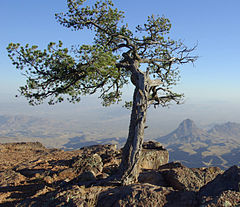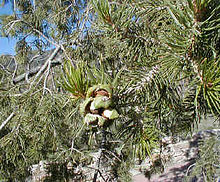- Mexican Pinyon
-
Mexican Pinyon 
Mexican Pinyon in Big Bend National Park, Texas Conservation status Scientific classification Kingdom: Plantae Division: Pinophyta Class: Pinopsida Order: Pinales Family: Pinaceae Genus: Pinus Subgenus: Ducampopinus Species: P. cembroides Binomial name Pinus cembroides
Zucc.The Mexican Pinyon (Pinus cembroides) is a pine in the pinyon pine group, native to western North America.
Contents
Distribution
The range extends from westernmost Texas, United States (where it is restricted to the Chisos and Davis Mountains), south through much of Mexico, occurring widely along the Sierra Madre Oriental and Sierra Madre Occidental ranges, and more rarely in the eastern Eje Volcánico Transversal range.[1] It lives in areas with little rainfall, which fluctuates between 380 millimetres (15 in) to 640 millimetres (25 in), the subspecies orizabensis (Pinus orizabensis) is found farther south in the state of Veracruz. There is also a disjunct population in the Sierra de la Laguna of southern Baja California Sur. It occurs at moderate altitudes, mostly from 1,600 metres (5,200 ft) to 2,400 metres (7,900 ft).
Description
Pinus cembroides is a small to medium-size tree, reaching 8 metres (26 ft) to 20 metres (66 ft) tall and with a trunk diameter of up to 50 centimetres (20 in). The bark is dark brown, thick and deeply fissured at the base of the trunk. The leaves ('needles') are in mixed pairs and threes, slender, 3 centimetres (1.2 in) to 6 centimetres (2.4 in) long, and dull yellowish green, with stomata on both inner and outer surfaces.
The cones are globose, 3 centimetres (1.2 in) to 4 centimetres (1.6 in) long and broad when closed, green at first, ripening yellow-brown when 18–20 months old, with only a small number of thick scales, with typically 5-12 fertile scales. The cones open to 4 centimetres (1.6 in) to 5 centimetres (2.0 in) broad when mature, holding the seeds on the scales after opening. The seeds are 10 millimetres (0.39 in) to 12 millimetres (0.47 in) long, with a thick shell, a pink endosperm, and a vestigial 2 millimetres (0.079 in) wing; they are dispersed by the Mexican Jay, which plucks the seeds out of the open cones. The jay, which uses the seeds as a major food resource, stores many of the seeds for later use, and some of these stored seeds are not used and are able to grow into new trees.
History
Mexican Pinyon was the first pinyon pine described, named by Zuccarini in 1832. Many of the other pinyon pines have been treated as varieties or subspecies of it at one time or another in the past, but research in the last 10–50 years has shown that most are distinct species. Some botanists still include Johann's Pinyon and Orizaba Pinyon in Mexican Pinyon; the former accounts for records of "Mexican Pinyon" in southern Arizona and New Mexico.
Mexican Pinyon is a relatively non-variable species, with constant morphology over the entire range except for the disjunct population in the Sierra de la Laguna pine-oak forests of Baja California Sur; this is generally treated as a subspecies, Pinus cembroides subsp. lagunae, although some botanists treat it as a separate species, P. lagunae. This subspecies differs from the type in having slightly longer leaves, between 4 centimetres (1.6 in) and 7 centimetres (2.8 in) and longer, narrower cones, up to 5.5 centimetres (2.2 in) long.
The seeds are widely collected in Mexico, being the main edible pine nut in the region.
Notes
References
- Conifer Specialist Group (1998). Pinus cembroides. 2006. IUCN Red List of Threatened Species. IUCN 2006. www.iucnredlist.org. Retrieved on 12 May 2006.
External links
Categories:- IUCN Red List least concern species
- Pinus
- Trees of Mexico
- Trees of Northern Mexico
- Trees of Baja California Sur
- Trees of Arizona
- Trees of New Mexico
- Trees of Western Texas
- Trees of temperate climates
- North American desert flora
- Drought-tolerant trees
- Edible nuts and seeds
- Least concern plants
Wikimedia Foundation. 2010.


